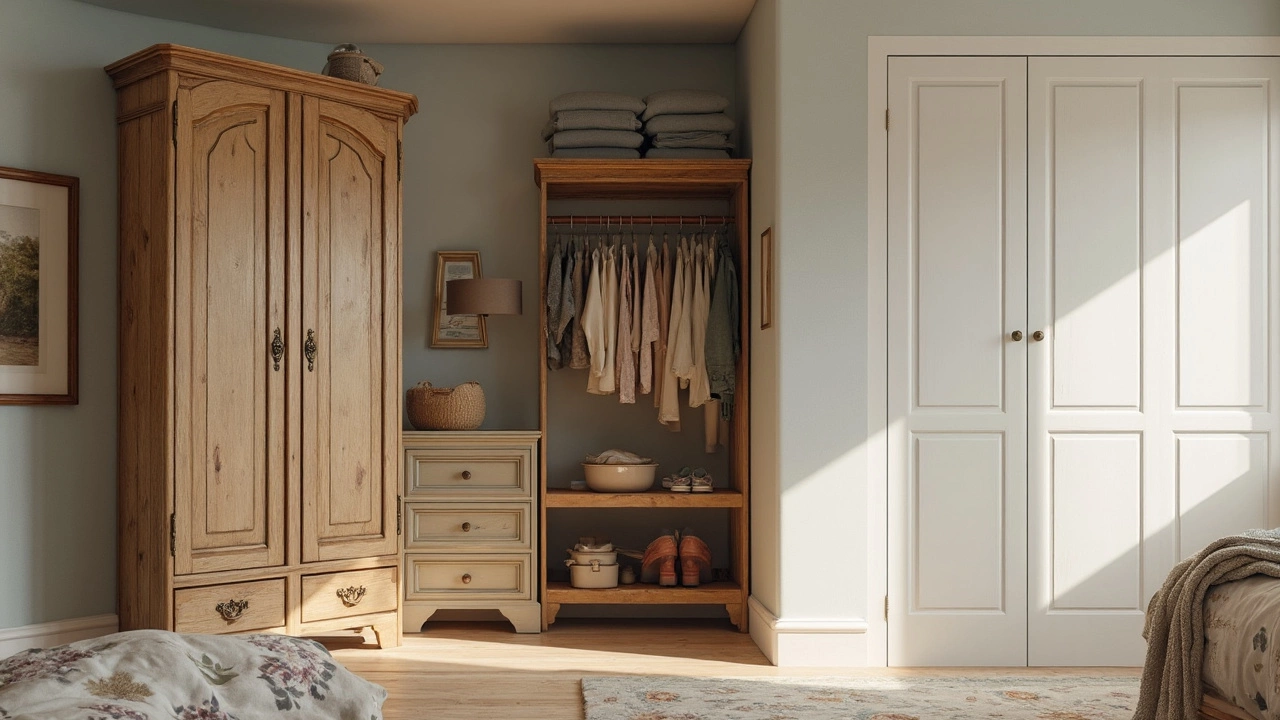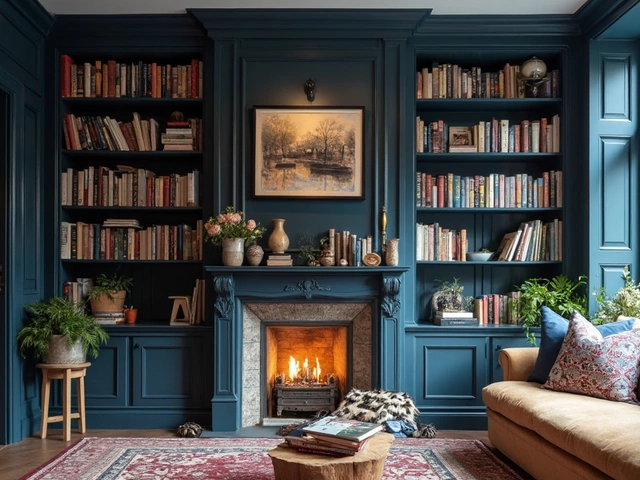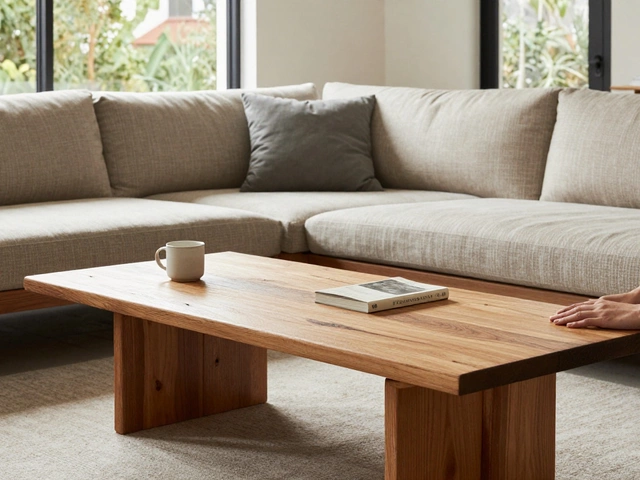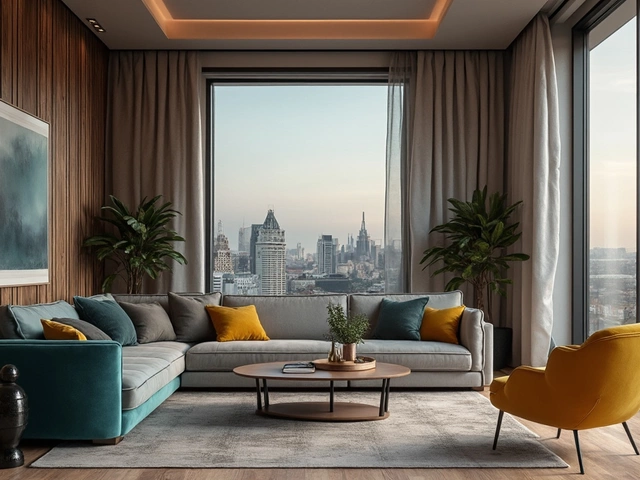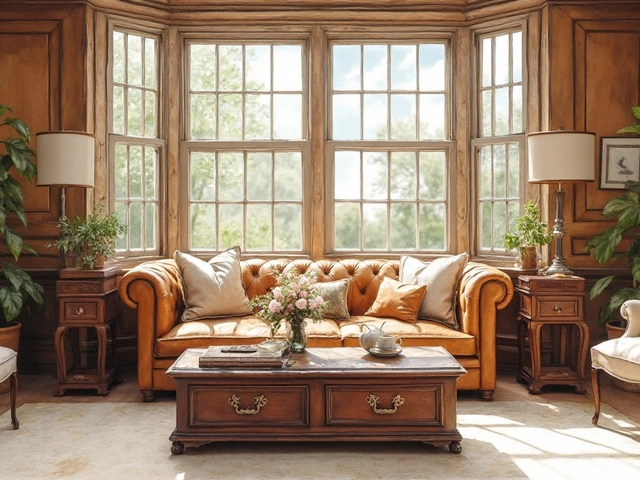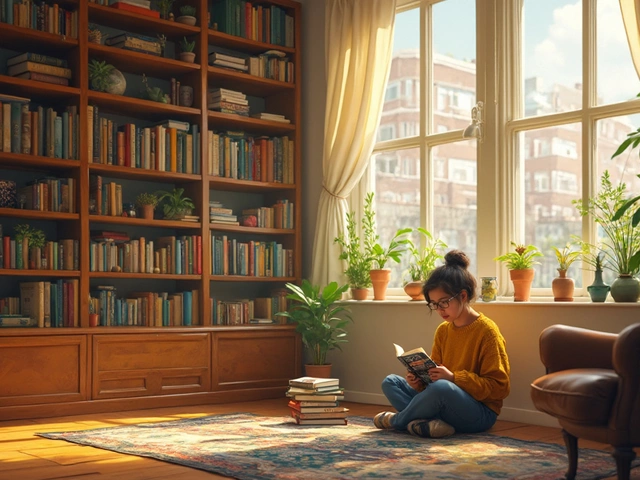Stand back and take a look around your bedroom for a second. Do you see a big piece of furniture standing quietly by the wall? Or are your shirts, pants, and shoes tucked away behind a door that blends right into the architecture? You might call both setups "places to put clothes," but the words "wardrobe" and "closet" actually mean two surprisingly different things. And trust me, as someone who's dealt with both in city apartments and spacious houses, picking the right one can save you heaps of headaches and actually make daily life feel a bit less chaotic.
The True Definitions: What Is a Wardrobe? What Is a Closet?
Let’s get precise right away: a wardrobe is a big, freestanding furniture piece, usually with doors, shelves, maybe a hanging rod, and sometimes even drawers. It stands alone—imagine the iconic Narnia wardrobe, the kind you can shove across the room if you need to. These aren’t built in; you bring them in whole, or sometimes assemble them, and you can move them when you shift house or rearrange. They’ve been around for centuries, originally showing up in European castles before regular homes had built-in storage. Plenty of Kiwi homes, especially older villas or cottages, still use wardrobes because the wall space is already spoken for by windows and fireplaces. They come in every style from practical IKEA basics to ornate antiques passed down through generations. Some people even treat a wardrobe like décor—a spot to display favorite bags or let a pop of color brighten the bedroom.
Now, a closet is a whole different beast. In most modern homes—especially newer builds in Auckland and across New Zealand—a closet is a dedicated, built-in storage space. Think: a nook or alcove in your wall, often with a sliding or hinged door that matches the room’s trim. It’s part of the house’s frame and layout. Closets can be absurdly small (enough for a handful of T-shirts and two pairs of shoes) or gigantic walk-in rooms where you could host a small party. Builders first started putting closets in American homes in the 19th century, and by the 1950s, they caught on big time all over the developed world, including here. They’re usually basic at first, but you can jazz them up with custom shelving, racks, and even lighting. You can’t unplug a closet and move it to another house, but you can knock one out if you’re knocking down a wall or remodelling.
Key Differences: Practical Use and Personality
On paper, both wardrobes and closets exist for one main reason: to help you wrangle your ever-growing pile of clothing, accessories, and shoes. But their real differences come down to how they function and the vibe they add to your home. If you’ve got a wardrobe, it’s almost always the most dominant piece of furniture in that room. Need a quick change? Pull open the doors, and everything’s visible—sometimes even a bit too visible if you’re as untidy as my mate Simon. Wardrobes can be styled for personality; people commonly choose finishes or colors that say something about their taste, or even line the inside with wallpaper for a special touch. They’re perfect for renters because you don’t need the landlord’s permission to bring one in, and you can take it when you move.
Closets, meanwhile, are more cool-headed and subtle. They’re built into the bones of the house, which gives you back more usable floor space. This is gold in cramped Auckland bedrooms where you’re fighting for that last bit of wall to put a desk or a dresser. The closet stays out of sight, so your room looks bigger and less cluttered. Plus, because they’re structural, you can often customize the layout—my spouse, Cerys, spent a whole weekend last year building in drawers and shoe racks to turn our boring master closet into something Martha Stewart would be proud of. You can add hooks for hats, shelving for folded shirts, or even set up a little safe box in the back for valuables (not that we’re hiding anything exciting… mostly old birthday cards and some cash).
Another big practical difference? Closets tend to be more stable. They’re less likely to wobble or tip over (wardrobes famously threaten to do just that if you stash too much on one side). But if you’re living in a place where earthquakes are a thing—like New Zealand—wardrobes do let you change layouts in a hurry. Safety tip: always anchor freestanding wardrobes to the wall if you have young kids or pets zooming about.
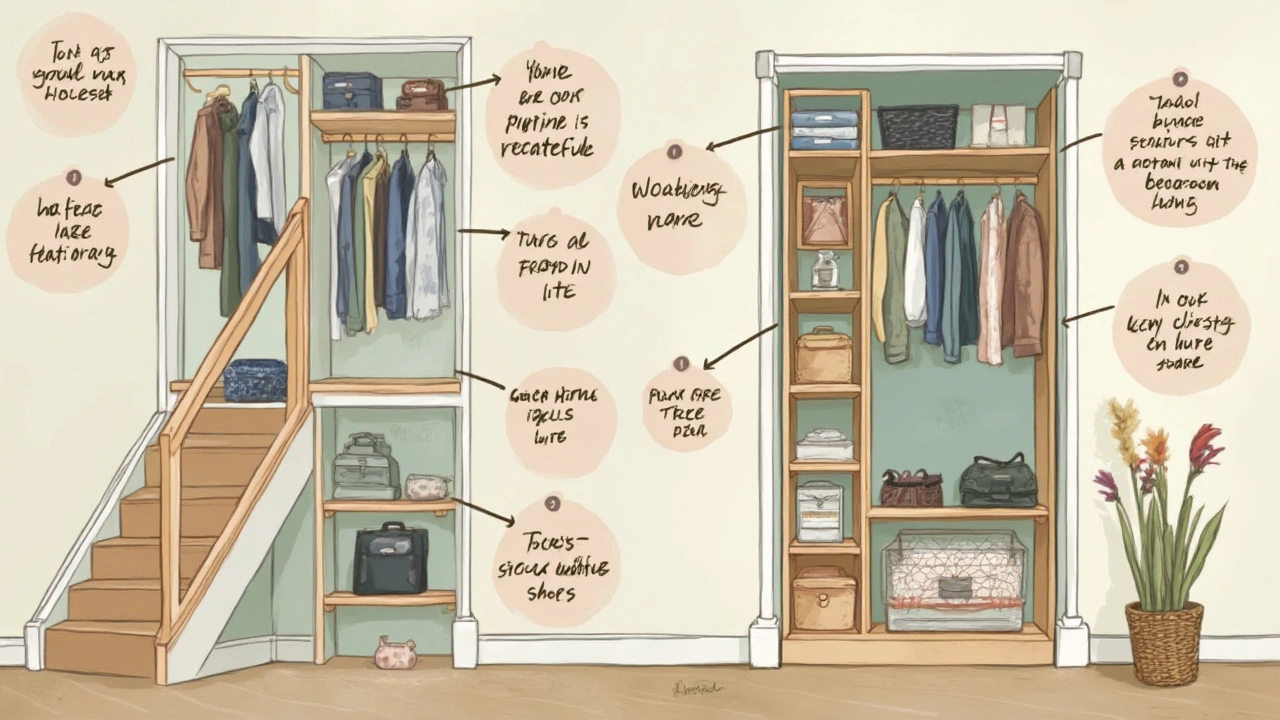
Origins and Cultural Differences: Why Words Matter
It’s not just the structure that separates wardrobes from closets; there’s some cultural flavor here too. The word "wardrobe" comes from old French—back in the medieval days, it literally meant a room (or a cabinet) where you kept robes. In much of the world—including the UK, New Zealand, Australia, and Ireland—"wardrobe" still gets tossed around as the main word for any kind of clothes storage, built-in or otherwise. I grew up in Auckland calling the built-in storage spots “wardrobes,” and only later did I realize Americans use "closet" almost exclusively, even for cupboards in the hallway. The Harry Potter world had us picturing poor kids living in a cupboard under the stairs—similar to a closet, but with less style and definitely less room to hide Christmas presents.
Across the US and Canada, “closet” rules the roost, and wardrobes are mostly what you’d see in a hotel suite or older home. Funny enough, the American wardrobe has often been a response to a house not having enough closets. In Europe, “wardrobe” spans both the furniture and what you keep inside it—so if someone says “I just bought a new wardrobe,” you might want to clarify if they mean a stylish new coat or a whole new cupboard. This difference matters less for furniture shoppers these days with global brands, but when friends visit from overseas, you quickly see the confusion pop up.
Kids can sense the difference, too. Our daughter once tried to turn a standalone wardrobe into her secret hideaway, claiming it felt "like magic." Try that in a standard closet and you’ll probably just bang your knee. The storybook charm of wardrobes is why they pop up in fantasy tales: you can basically stash away a secret kingdom or just your winter boots. Closets, on the other hand, are where most grown-ups stash extra towels or hide Christmas gifts from their sneaky partners (not that Cerys and I would ever do that, of course).
Design, Space, and Style: Choosing What Works for You
Let’s talk about the big factors—space, style, and your day-to-day life. In tight or oddly-shaped rooms, a wardrobe can be a lifesaver: you measure the footprint, pick a size, and place it where it fits. Need the window left open or want to leave an awkward alcove free for a desk? No worries—just slide the wardrobe to the other wall. It’s also ideal when you crave added flexibility; maybe you’ll want a bookcase one day, or that side of the room will house a crib and baby gear soon. Wardrobes are simple to change out as fashion or needs evolve—my brother, when he moved into a flat, grabbed a secondhand wardrobe for next to nothing and had storage sorted before the electricity was even turned on.
But when space is really at a premium, especially in those skinny terrace homes around Auckland, a built-in closet can make things feel less jammed. Instead of swinging doors (which eat up floorspace), most closets use sliding doors. You can even do away with doors and go for open shelving with baskets if you love the open-concept feel. Some folks add built-in closets with mirrored doors for extra light—small bedrooms instantly look less cramped, and you get a two-for-one storage and dressing solution.
Styling a closet is all about the interior. Clever use of hanging rods at different heights makes space for everything from long dresses to stacked shirts. Add in pull-out baskets for socks or accessories, and suddenly the morning rush is less of a mad scramble. If your thing is shoes, putting racks in at an angle makes every pair easy to spot (and makes you feel a bit like you’re in a boutique). On the flip side, wardrobes can be enhanced with extra drawers, baskets, or even mini LED strip lights so you can see into the dark corners. Don’t be shy about sticking up a few hooks for belts, ties, or scarves.
No matter what you choose, organizing is the secret weapon. Experts in home organization agree: declutter first, then figure out what you genuinely use—all before you ever pick a storage solution. Buying a massive wardrobe for clothes you never wear is just adding to the chaos. Think in terms of zones: everyday wear in the most accessible spots, formal wear up high or at the back, shoes in a spot that lets them air, and accessories in easy-to-reach trays or boxes.
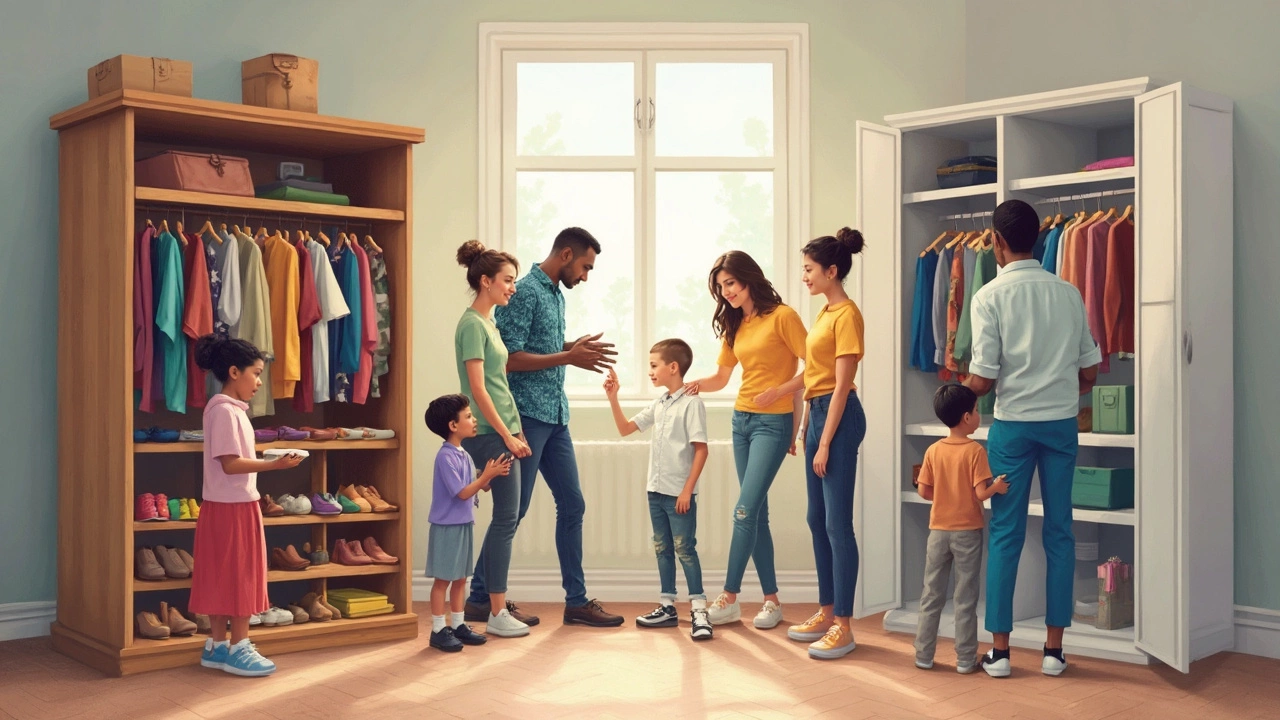
Tips for Making the Best Choice for Your Space
Here’s the trick: don’t assume there’s a universal right answer. Both wardrobes and closets have their strong points! Ask yourself: Are you renting, or do you own your home? If you plan to move in the next year or two, a freestanding wardrobe is the practical option. They take more space, sure, but you won’t lose your investment when you change addresses. Want to hide away clutter and make the most of every inch? Closets are hard to beat, especially with the right shelves and organizers inside.
If you’re dealing with a long, narrow room, careful measuring is key. You might find a built-in closet makes sense along one end, opening up the rest of the space for a bed and desk. For rooms with uneven walls, sloped ceilings, or awkward nooks (classic in old Kiwi bungalows), wardrobes give you far more flexibility. And don’t forget surface finish and style—Cerys once convinced me to paint an old wardrobe mint green, which sounded nuts but made the room feel fresh and modern.
Looking to mix both? Don’t stress. Plenty of people use a closet for main storage and add a slimline wardrobe or armoire for overflow, seasonal gear, or just to show off a few favorite pieces. This is especially handy if, say, you and your partner have very different tastes—one can claim the wardrobe, one the closet, and each can organize their "territory" without any rows over hanger space.
Little details make a massive difference. If you’re building, ask about the possibility of walk-in closets—the holy grail for many, and genuinely worth fighting for if you can spare the square meters. They give you room to step inside, sort, and even stash laundry hampers or a full-length mirror. On the other hand, if money’s tight, hunting Facebook Marketplace or neighborhood garage sales for secondhand wardrobes can snag you a way better piece than anything flat-packed new.
For anyone who cares about reducing clutter and stress, here’s the biggest tip: commit to regular cleanouts. Every six months, take a hard look at everything in your closet or wardrobe. Chuck anything you haven’t worn in a year (be honest—no one is judging that wild shirt from your 20s). Add some drawer organizers or shelf dividers. This keeps your storage working for you, not just hiding last season’s chaos behind closed doors.
There’s something pretty satisfying about finally taming all those clothes and creating a space that makes you feel calm, sorted, and like you’re not losing socks at every turn. And whether you do it with a centuries-old wardrobe or a closet upgraded with all the modern bells and whistles, that win never gets old. Pick what makes your life easier and your room feel right. Your future self on a groggy Monday morning will thank you.
